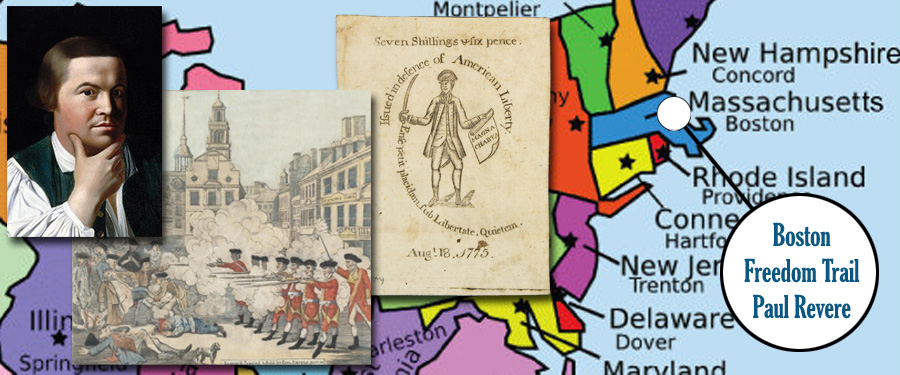
This week we continue our hypothetical road trip across America by stopping in Boston, Massachusetts, a city where numismatists could spend quite a bit of time, especially if their collecting interests coincide with a fascination with history. Our numismatic focus while visiting "Beantown" is most definitely historic — Paul Revere.
While Paul Revere is sometimes linked with certain early American coins, including the Pitt token and the Massachusetts copper pieces of 1776, he is most often remembered numismatically as the engraver of currency authorized by the Continental Congress, including the famous Sword in Hand notes of 1775.
There is no shortage of Paul Revere sites to visit in Boston, but here I will mention four that can be easily visited as part of Boston’s Freedom Trail, more details of which can be found at theFreedomTrail.org. They are listed here in the order that they are encountered on the trail.
Now, full disclosure, I have a love/hate relationship with the Freedom Trail. After my family relocated to Massachusetts from the Midwest when I was seven years old, any relatives or friends who came to visit us were taken by my father (a true history buff) to Boston to walk the Freedom Trail — all of it, brick by brick, no shortcuts. My mother, brothers, sister and I were encouraged (forced) to go along with only the hope of a hot fudge sundae at Bailey’s near the Boston Common to reward us for the effort.
Granary Burying Ground
Established in 1660, some of America’s most notable citizens rest here. Named for the 12,000-bushel grain storage building that was once next-door, the historic cemetery has 2,300 markers. Paul Revere is buried near the back of the Granary — a large marker placed in the 19th century stands by a smaller, older slate marker. Also of note are: the Infant’s Tomb, where hundreds of children have been interred; the grave of Benjamin Franklin’s parents; John Hancock’s tomb; matching stones commemorating patriots James Otis and Samuel Adams; the grave marker for the victims of the Boston Massacre, and a plaque marking the tomb of Robert Treat Paine, the third signer of the Declaration of Independence buried in the Granary (the others being John Hancock and Samuel Adams).
Numismatic note: Located between Paul Revere’s burial place and the grave of Ben Franklin’s parents is Hull’s Tomb, burial place of John Hull, mintmaster of the Massachusetts Bay Colony.
The Boston Massacre Site
While Paul Revere was likely not in attendance at the famous March 5, 1770, clash between Redcoats and an angry mob of Bostonians, his widely-circulated historic engraving, "The Bloody Massacre in King-Street," may be the most effective piece of war propaganda in American history.
Today, a ring of stones on the Freedom Trail marks the site of the Boston Massacre and reenactments hosted by the Bostonian Society take place each year on the anniversary of the event.
The Paul Revere House
Built around 1680, the Paul Revere House is the oldest remaining structure in downtown Boston and the only home on the Freedom Trail. Paul Revere purchased the dwelling in 1770, and he and his family lived there when Revere made his famous ride to Lexington on the night of April 18-19, 1775, later immortalized in Longfellow’s famous poem Paul Revere’s Ride.
At various times, Revere shared this house with his mother and nine of his children from two marriages. Throughout the 19th-century the home served as a boardinghouse for sailors and a tenement for Irish, Jewish, and Italian immigrants who lived in the North End. Later it was restored and is owned and operated by the Paul Revere Memorial Association. There is a museum as well as guided tours and special programs.
The Old North Church
Christ Church, also known as Old North Church, opened on December 29, 1723, and is the oldest standing church building in Boston. On April 18, 1775, Paul Revere and the church’s sexton Robert Newman came up with a way to signal the advancement of British troops towards Lexington and Concord. Newman and fellow Sons of Liberty Captain Pulling climbed the stairs and ladders up eight stories to hang two lanterns for a few moments, long enough for patriots in Charlestown to learn that the British were crossing the Charles River by boat — the "one if by land, two if by sea" in Longfellow’s poem. Also to be found nearby is the famous statue of Paul Revere by Cyrus E. Dallin, numismatically remembered as the designer of the 1920 Pilgrim Tercentenary half dollar.
On a personal note, the Old North Church was a highlight on our family Freedom Trail adventures, mainly because it was usually the last stop. In addition, if my parents were in a generous mood, they would sometimes buy us each a candy stick in the gift shop — I think they cost 10¢ each. It was the 1970s and kids didn’t expect so much.
Other Nearby Attractions
In truth there are so many nearby attractions in Boston that it would be impossible to list them all, but perhaps you want to relax after the Freedom Trail as Paul Revere might by heading to the Warren Tavern in Charlestown. Built in 1780, the Warren is the oldest tavern in Massachusetts and was visited by Paul Revere and George Washington, among other famous figures. The tavern’s website claims that Paul Revere considered it "one of his favorite watering holes."





